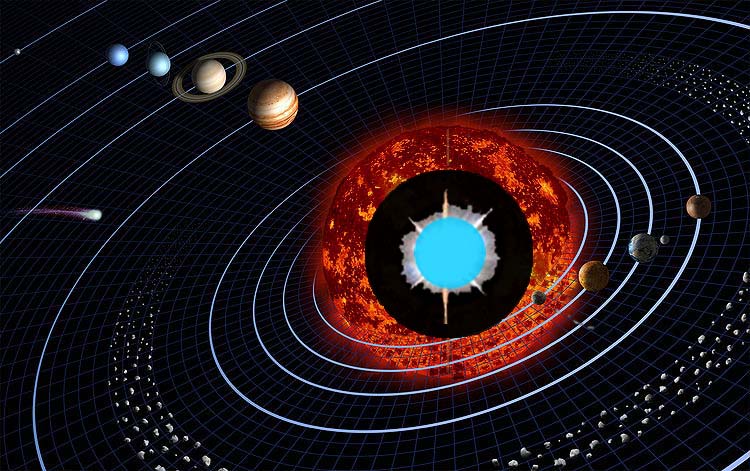
Central black sphere indicates the size of the hypothesized gravitationally lensed black hole event horizon compared to Mercury’s orbit (inner circle). The white source inside indicates the comparable size of the observed microwave emission region. The blue sphere within that is the best estimate for the size of the Sgr A* mother star.
Conventional astronomy has for decades maintained that the core of our Galaxy harbors a black hole singularity. The latest estimate places the mass of the core at 4.0 ± 0.3 million solar masses. Since its first publication in 1985, subquantum kinetics has maintained that black holes can’t form. It maintains that the massive objects in the cores of galaxies are instead very massive, very old stellar cores which are kept from collapsing by the prodigious amount of “genic” energy produced in their interior through the predicted photon blueshifting effect.
Subquantum kinetics has maintained that Sgr A* is not a black hole, but a “mother star.” New observational evidence of the Galactic core that has been coming in favors this subquantum kinetics interpretation. Recently, it has been determined that Sgr A* has a diameter of just 37 micro arc seconds or 39 million km if we assume a Galactic center distance of 23,000 light years. This is about one third the diameter of Mercury’s orbit or 28 times the diameter of the Sun. By comparison, a 4.0 million solar mass black hole is calculated to have a Schwarzschild radius of 13.3 million kilometers and due to gravitational lensing the Schwarzschild event horizon should appear to us to have a diameter of 69 million km (5.2 times larger than the Schwarzschild radius). This would be about 56 percent the diameter of Mercury’s orbit. So the Galactic center is actually observed to have a radius almost half as large as is predicted by black hole theory. That is, radio emission is coming from a region which black hole theory predicts should be completely dark, from which light should not escape!
Black hole theorists have tried to get around this by claiming that this radio emission is not coming directly from Sgr A* but from its immediate vicinity from a region close to the surface of its event horizon. But if this were the case, this emission region should be observed to orbit Sgr A* or at least rotate around Sgr A* participating in the rotation of the “black hole’s” event horizon envelope.
But no such rotation is seen (see January 2011 article in Science News). If the black hole theory were correct, some degree of rotary motion would be expected since infalling material is theorized to add angular momentum to the black hole causing it to rotate. Instead, astronomers observing the emission from Sgr A* at millimeter wavelengths have determined that it is spinning either very slowly or not at all (http://arxiv.org/abs/1011.2770). Even if it had not “dined” in a while some amount of rotation would be expected to remain from its previous dining event. To explain its prodigious cosmic ray emission rather frequent mass accretion would be required. Finding matter in its immediate vicinity to accrete is another problem since its radiation pressure has swept this inner region clear of gas and dust.
So the bottom line is that the black hole explanation for the Galactic center is in serious trouble. Anyone with an objective mind quickly realizes why the Sgr A* emission is not moving, i.e., not orbiting any hypothetical central mass; it is because the emission is coming directly from Sgr A* not from any hypothetical accretion disc. Since direct emission from within the gravitationally lensed Schwarzschild singularity is impossible according to black hole theory, we are lead inevitably to conclude that Sgr A* is not a black hole. It is a mother star, a very dense, primordial, energy-and-matter-generating stellar core. The best estimate gives it a diameter about 21.6 times that of the Sun, or about one-fourth the diameter of Mercury’s orbit. The mother star is shown as the blue sphere in the above image. For further details about mother stars see Subquantum Kinetics.
